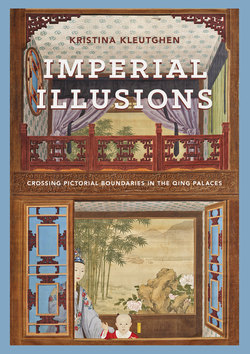Читать книгу Imperial Illusions - Kristina Kleutghen - Страница 46
На сайте Литреса книга снята с продажи.
Оглавлениеin Rome send large masterpieces as well as a European painter capable of producing such works. Although the painter never arrived, leaving Ricci to rely on Niccolò-trained artists, some paintings and numerous prints were sent, becoming the first examples of post-Renaissance European art to circulate in China as well as the foundation for the illustrations in Jesuit-sponsored printed books.48
The Jesuit Jerome Nadal’s (1507–80) famous Evangelicae historiae imagines ex ordine Evangeliorum quae toto anno in Missae Sacrificio recitantur (printed in Antwerp between 1593 and 1595) became the source for the two best-known illustrated books that the Jesuits printed in seventeenth-century China, which are the first clear examples of the blending of Chinese and European representational methods that would later characterize Qing court painting. Rules for Reciting the Rosary (Song nianzhu guicheng, c. 1619–23) is credited to Gaspar Ferreira, S.J. (Fei Qigui, 1571–1649), and João da Rocha, S.J. (Luo Ruwang, 1583–1623), and Illustrated Explanation of the Incarnation of the Lord of Heaven (Tianzhu jiangsheng chuxiang jingjie, 1637) to Giulio Aleni, S.J. (Ai Rulüe, 1592–1649).49 It is important to note that only Nadal’s images were transferred, and not the technology of copperplate engraving with which his book was printed. Both of these Chinese books are woodblock printed, taking advantage of the highly developed printing industry that played such an important role in late Ming visual culture, but it is unclear whether Ferreira, da Rocha, and Aleni were themselves responsible for the illustrations in the books, as the identities of the artists, block carvers, and printers are unknown. However, the diverse ways in which these illustrations combine Chinese and European pictorial devices provide concrete examples of how the artists, whomever they might have been, were integrating new and established conventions.
Depicting the Annunciation (figure. 1.4), the first illustration in Rules for Reciting the Rosary is one of only two illustrations in the book set in an identifiably Chinese environment appropriate for a literati scholar-official. Although the Virgin and the angel wear Western-style robes consistent with the foreign costumes found throughout the book, the scene occurs in an unmistakably Ming private home, in a room elegantly furnished with a daybed and a tall four-legged table that the Virgin uses as a prie-dieu. The room opens onto a garden, only just visible at the left side of the image, in which banana plants identify the scene as set in southeastern China, the literati heartland. Behind the Virgin is not, as might appear at first glance, a view onto the surrounding landscape, but rather a large standing screen with an ink painting in the sparse style of Yuan literati landscape master Ni Zan (1302–74). This would have been an ideal and highly valued painting for a literatus to own, especially given the importance of Ni Zan in orthodox landscape painting and as a model literatus. Rather than closing off the image, however, the representation of the screen painting, with its characteristic Ni Zan composition split between foreground and background over a visible distance, serves to deepen the sense of interior space in the overall scene. The background mountains are depicted on a smaller scale than the rocks and dead tree in the foreground, which, along with the blank paper visible
